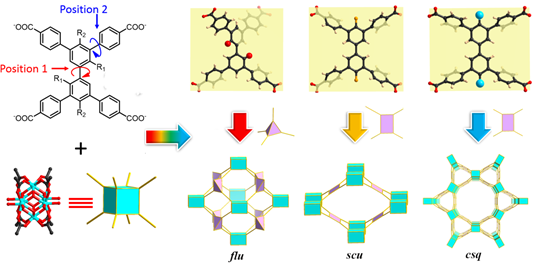Due to the potential applications in gas storage and separation, metal-organic frameworks (MOFs), which are a new class of highly porous crystalline materials, have rapidly developed in the past two decades. However, how to effectively obtain the targeted MOFs by the precise control of the conformations of the ligands is still a big challenge.
In a study published in J. Am. Chem. Soc., the research group led by Prof. HONG Maochun from Fujian Institute of Research on the Structure of Matter of the Chinese Academy of Sciences reported the precise control of the structure of Zr-tetracarboxylate frameworks through steric tuning.
In order to selectively synthesize different structures, a series of tetratopic carboxylate ligands with similar backbones but different substituents have been designed. Through the organic substituents R1 and R2, the conformations of the organic ligands can be precisely controlled from the tetrahedral symmetry to planar C2h and C2v symmetry. Therefore, three kinds of different frameworks with flu, scu and csq topologies can be obtained.
Molecular simulations show that the steric hindrance of the R1 and R2 substituents directs the resulting MOF structures. In addition, the judicious combinations of different linkers also result in specific structures.
The above results shed light on the precise design and synthesis of desired MOF structures for specific applications.

Construction of the Zr-MOFs with three types of topologies by precisely controlling the conformations of the ligands. (Image by Prof. HONG’s Group)
Contact:
Prof. HONG Maochun
Fujian Institute of Research on the Structure of Matter
Chinese Academy of Sciences
Email: hmc@fjirsm.ac.cn